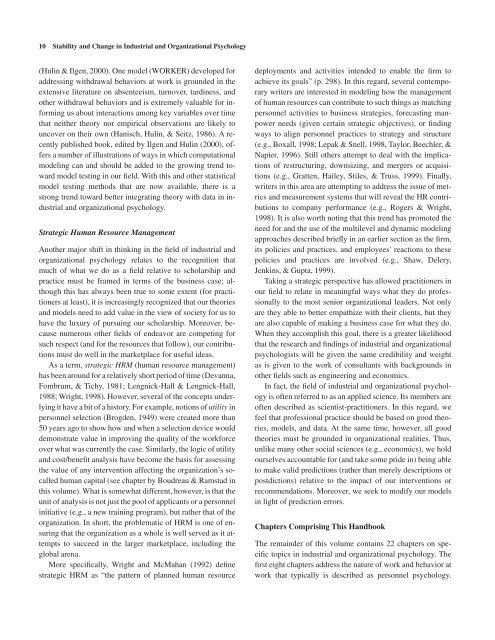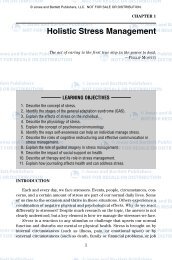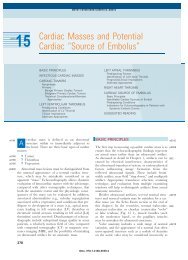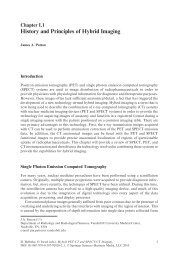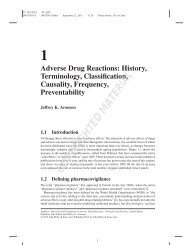Stability and Change in Industrial and Organizational ... - Axon
Stability and Change in Industrial and Organizational ... - Axon
Stability and Change in Industrial and Organizational ... - Axon
You also want an ePaper? Increase the reach of your titles
YUMPU automatically turns print PDFs into web optimized ePapers that Google loves.
orm_ch01.qxd 9/26/02 2:59 PM Page 10<br />
10 <strong>Stability</strong> <strong>and</strong> <strong>Change</strong> <strong>in</strong> <strong>Industrial</strong> <strong>and</strong> <strong>Organizational</strong> Psychology<br />
(Hul<strong>in</strong> & Ilgen, 2000). One model (WORKER) developed for<br />
address<strong>in</strong>g withdrawal behaviors at work is grounded <strong>in</strong> the<br />
extensive literature on absenteeism, turnover, tard<strong>in</strong>ess, <strong>and</strong><br />
other withdrawal behaviors <strong>and</strong> is extremely valuable for <strong>in</strong>form<strong>in</strong>g<br />
us about <strong>in</strong>teractions among key variables over time<br />
that neither theory nor empirical observations are likely to<br />
uncover on their own (Hanisch, Hul<strong>in</strong>, & Seitz, 1986). A recently<br />
published book, edited by Ilgen <strong>and</strong> Hul<strong>in</strong> (2000), offers<br />
a number of illustrations of ways <strong>in</strong> which computational<br />
model<strong>in</strong>g can <strong>and</strong> should be added to the grow<strong>in</strong>g trend toward<br />
model test<strong>in</strong>g <strong>in</strong> our field. With this <strong>and</strong> other statistical<br />
model test<strong>in</strong>g methods that are now available, there is a<br />
strong trend toward better <strong>in</strong>tegrat<strong>in</strong>g theory with data <strong>in</strong> <strong>in</strong>dustrial<br />
<strong>and</strong> organizational psychology.<br />
Strategic Human Resource Management<br />
Another major shift <strong>in</strong> th<strong>in</strong>k<strong>in</strong>g <strong>in</strong> the field of <strong>in</strong>dustrial <strong>and</strong><br />
organizational psychology relates to the recognition that<br />
much of what we do as a field relative to scholarship <strong>and</strong><br />
practice must be framed <strong>in</strong> terms of the bus<strong>in</strong>ess case; although<br />
this has always been true to some extent (for practitioners<br />
at least), it is <strong>in</strong>creas<strong>in</strong>gly recognized that our theories<br />
<strong>and</strong> models need to add value <strong>in</strong> the view of society for us to<br />
have the luxury of pursu<strong>in</strong>g our scholarship. Moreover, because<br />
numerous other fields of endeavor are compet<strong>in</strong>g for<br />
such respect (<strong>and</strong> for the resources that follow), our contributions<br />
must do well <strong>in</strong> the marketplace for useful ideas.<br />
As a term, strategic HRM (human resource management)<br />
has been around for a relatively short period of time (Devanna,<br />
Fombrum, & Tichy, 1981; Lengnick-Hall & Lengnick-Hall,<br />
1988; Wright, 1998). However, several of the concepts underly<strong>in</strong>g<br />
it have a bit of a history. For example, notions of utility <strong>in</strong><br />
personnel selection (Brogden, 1949) were created more than<br />
50 years ago to show how <strong>and</strong> when a selection device would<br />
demonstrate value <strong>in</strong> improv<strong>in</strong>g the quality of the workforce<br />
over what was currently the case. Similarly, the logic of utility<br />
<strong>and</strong> cost/benefit analysis have become the basis for assess<strong>in</strong>g<br />
the value of any <strong>in</strong>tervention affect<strong>in</strong>g the organization’s socalled<br />
human capital (see chapter by Boudreau & Ramstad <strong>in</strong><br />
this volume). What is somewhat different, however, is that the<br />
unit of analysis is not just the pool of applicants or a personnel<br />
<strong>in</strong>itiative (e.g., a new tra<strong>in</strong><strong>in</strong>g program), but rather that of the<br />
organization. In short, the problematic of HRM is one of ensur<strong>in</strong>g<br />
that the organization as a whole is well served as it attempts<br />
to succeed <strong>in</strong> the larger marketplace, <strong>in</strong>clud<strong>in</strong>g the<br />
global arena.<br />
More specifically, Wright <strong>and</strong> McMahan (1992) def<strong>in</strong>e<br />
strategic HRM as “the pattern of planned human resource<br />
deployments <strong>and</strong> activities <strong>in</strong>tended to enable the firm to<br />
achieve its goals” (p. 298). In this regard, several contemporary<br />
writers are <strong>in</strong>terested <strong>in</strong> model<strong>in</strong>g how the management<br />
of human resources can contribute to such th<strong>in</strong>gs as match<strong>in</strong>g<br />
personnel activities to bus<strong>in</strong>ess strategies, forecast<strong>in</strong>g manpower<br />
needs (given certa<strong>in</strong> strategic objectives), or f<strong>in</strong>d<strong>in</strong>g<br />
ways to align personnel practices to strategy <strong>and</strong> structure<br />
(e.g., Boxall, 1998; Lepak & Snell, 1998, Taylor, Beechler, &<br />
Napier, 1996). Still others attempt to deal with the implications<br />
of restructur<strong>in</strong>g, downsiz<strong>in</strong>g, <strong>and</strong> mergers or acquisitions<br />
(e.g., Gratten, Hailey, Stiles, & Truss, 1999). F<strong>in</strong>ally,<br />
writers <strong>in</strong> this area are attempt<strong>in</strong>g to address the issue of metrics<br />
<strong>and</strong> measurement systems that will reveal the HR contributions<br />
to company performance (e.g., Rogers & Wright,<br />
1998). It is also worth not<strong>in</strong>g that this trend has promoted the<br />
need for <strong>and</strong> the use of the multilevel <strong>and</strong> dynamic model<strong>in</strong>g<br />
approaches described briefly <strong>in</strong> an earlier section as the firm,<br />
its policies <strong>and</strong> practices, <strong>and</strong> employees’ reactions to these<br />
policies <strong>and</strong> practices are <strong>in</strong>volved (e.g., Shaw, Delery,<br />
Jenk<strong>in</strong>s, & Gupta, 1999).<br />
Tak<strong>in</strong>g a strategic perspective has allowed practitioners <strong>in</strong><br />
our field to relate <strong>in</strong> mean<strong>in</strong>gful ways what they do professionally<br />
to the most senior organizational leaders. Not only<br />
are they able to better empathize with their clients, but they<br />
are also capable of mak<strong>in</strong>g a bus<strong>in</strong>ess case for what they do.<br />
When they accomplish this goal, there is a greater likelihood<br />
that the research <strong>and</strong> f<strong>in</strong>d<strong>in</strong>gs of <strong>in</strong>dustrial <strong>and</strong> organizational<br />
psychologists will be given the same credibility <strong>and</strong> weight<br />
as is given to the work of consultants with backgrounds <strong>in</strong><br />
other fields such as eng<strong>in</strong>eer<strong>in</strong>g <strong>and</strong> economics.<br />
In fact, the field of <strong>in</strong>dustrial <strong>and</strong> organizational psychology<br />
is often referred to as an applied science. Its members are<br />
often described as scientist-practitioners. In this regard, we<br />
feel that professional practice should be based on good theories,<br />
models, <strong>and</strong> data. At the same time, however, all good<br />
theories must be grounded <strong>in</strong> organizational realities. Thus,<br />
unlike many other social sciences (e.g., economics), we hold<br />
ourselves accountable for (<strong>and</strong> take some pride <strong>in</strong>) be<strong>in</strong>g able<br />
to make valid predictions (rather than merely descriptions or<br />
postdictions) relative to the impact of our <strong>in</strong>terventions or<br />
recommendations. Moreover, we seek to modify our models<br />
<strong>in</strong> light of prediction errors.<br />
Chapters Compris<strong>in</strong>g This H<strong>and</strong>book<br />
The rema<strong>in</strong>der of this volume conta<strong>in</strong>s 22 chapters on specific<br />
topics <strong>in</strong> <strong>in</strong>dustrial <strong>and</strong> organizational psychology. The<br />
first eight chapters address the nature of work <strong>and</strong> behavior at<br />
work that typically is described as personnel psychology.


